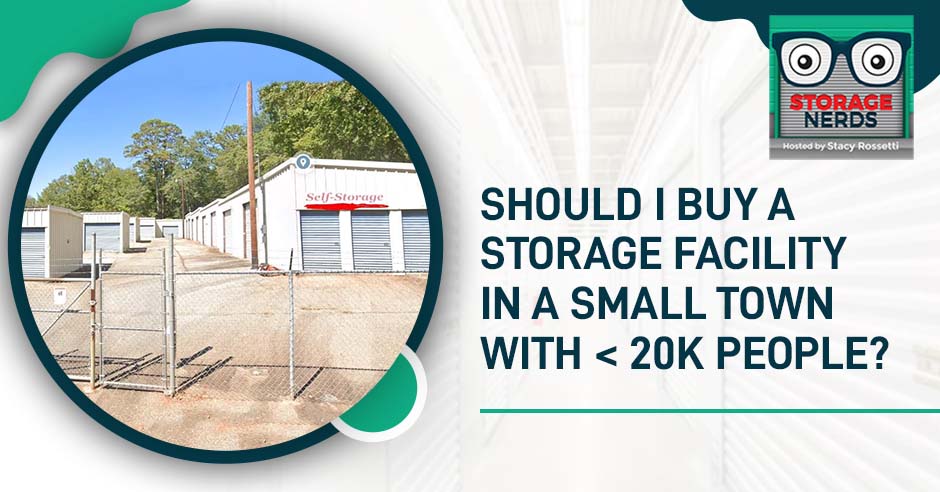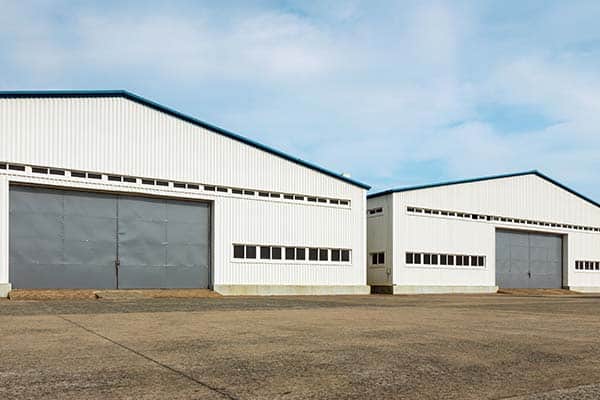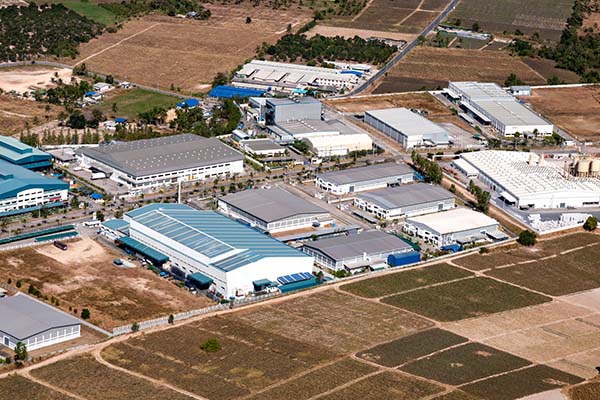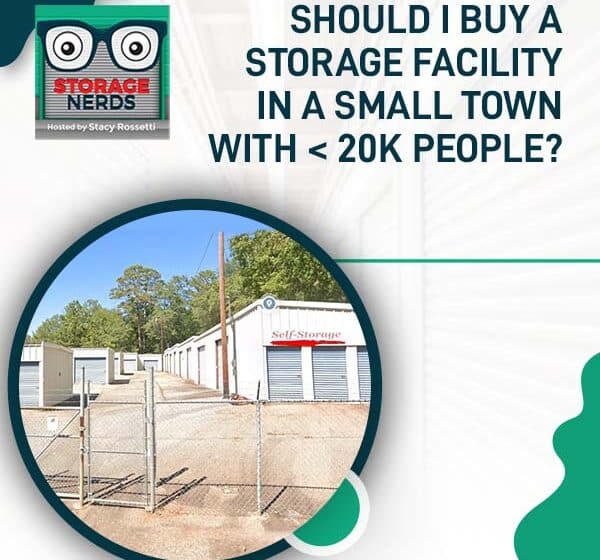
One of the most common pieces of investing advice is to invest in a growing market. In the storage business, they also tell you to buy 30,000 square feet or more. But what if you found a facility that does not meet those two criteria? Should you skip them altogether? In this episode, Stacy Rossetti offers fresh takes on these by taking us into another of her facilities. This one is a small facility in the middle of Georgia called Americas. Aside from being small, it is also situated in a town with less than 20k people. Listen to Stacy as she shares how she found it, funded it, and ran it. Most of all, find out what she saw in this facility that made her jump against the odds.
—
Watch the episode here
Listen to the podcast here
Should I Buy A Storage Facility In A Small Town With < 20k People?
We’re going to get into another one of my facilities. We have three more left. Over the course of the last 9 episodes, we’ve been through 9 of 12 of the facilities that we own. We have three more episodes. We have two facilities under contract. I’ll go over those as well. We’ll have all of the case studies available for those that buy the course. We’re going to stick those into the course so that you can re-read those as well too. Again, thank you for hopping on. I appreciate it.
We’re going to go over another one of my storage facilities. This is one that we bought in Middle Georgia. I’m going to share with you how I found it, fund it, and how my husband runs them. I’m going to get into that. Other than that, if you ask me questions along the way, anything on finding, funding, and running, I’ll answer those as well too. Let’s get into it.
If you’re new and never heard of me before and this is your first time, let me know. I appreciate everybody coming and hanging out. I teach almost every Monday. I will not be teaching on Halloween because I’m going to be taking my daughter, Lillian, to go trick-or-treating. I teach a different topic every Monday. You could always read and go over whatever comes up.
You Could Make Money With Smaller Facilities Too
What we’re going to do is we’re going to go over a deal that we found in a little tiny town in Georgia called Americus. We name all of our facilities after the town where we bought them. This is a tiny town. When you invest in self-storage, what most people that are in the storage business are going to tell you is, “In order to make money, you have to buy 30,000 square feet or more.” The truth is that you could make money with smaller facilities as well too. Not all of us can raise $3 million.
You could make money with smaller facilities too.
I have a student whose very first facility was $275,000 and her second facility was $3 million. She stabilized that property and got an offer for $6 million on it. You can make a lot of money at $3 million, but her $275,000 facility is worth over $1 million. You can also make a lot of money on little tiny facilities as well too. That’s the purpose of this coaching. I don’t focus on huge big facilities because the truth is everybody’s got to start somewhere.
I’m here to help you get your foot in the door and show you that it’s okay to buy something that’s smaller. You may find out that storage is not the way that you want to go after you buy your first one. Thank God because then you’re only out a couple hundred thousand dollars. I have a student that’s looking at a facility that the owner only had for several months and decided he didn’t want to do it anymore so he’s selling. It’s a little tiny facility. Not too small, but it’s not too big. The good thing is that he didn’t have to worry about that huge mortgage or anything like that too.
There’s nothing wrong with getting started in smaller facilities. That’s where I started out. We have 11 storage facilities and on average about 100 units. Some of them are smaller, so from 60 units to 125 units. We have eleven of those. We have one that’s a bigger facility. The truth is that the bigger ones are as much work as the smaller ones. If you can afford a bigger one, more power to you but if you can’t, then there’s nothing wrong with buying a smaller one.

What’s interesting too is that we were talking to Marcus. They were telling us a few months ago that secondary and tertiary markets are the hottest markets right now because primary markets are oversaturated. A lot of bigger players are turning to secondary markets. All the secondary market players are turning to tertiary markets because prices are getting to be a little bit more expensive, and cap rates are a little bit lower. Times are changing.
We’ve been putting in offers on facilities now since about June 2022. My acquisitions team puts in about ten offers a week. We started our acquisitions team in May. I say it took us a good 60 days to start putting offers in. After that, we’ve been putting in anywhere from 5 to 10 offers a week since July, August, and September, so 90 days. What we’re seeing out in the industry is that sellers still think their facilities are worth a lot.
The prices have not come down from the last few years of like craziness. Keep in mind that when you put offers in, it’s a numbers game. The more offers that you put in, the more chances that you have of finding something. Do not give up. We don’t give up. We’re looking for facilities for all of our students and it’s hard right now.
Keep in mind that putting in offers is just a numbers game. The more offers you put in, the more chances you have of finding something.
Another thing too that we’ve changed on our acquisition side is the bank financing terms. We’re running our numbers now at 25% down and 6.5% to 7% interest. If you want to get bank financing, what is the interest rate going to look like months from now? Do you think the Fed’s going to pivot and start going down? I don’t think so. It’s going to go up because they’ve already said that it’s going to be all the way through the summer of 2023. They’re going to keep increasing rates.
If you got an SBA loan, it’s going to take you up to six months to close. I had a student that closed with SBA and it took them six months to close. They don’t lock that interest rate in until like the day you can close. That’s how all banks do it because they’re waiting to see. I feel like the interest rates are only going to go up. We’ve been running our numbers.
Also, what we’ve noticed from students is that local banks are asking for 25% down. Keep that in mind. Bank financing, 25% down and 7% interest, and a DSR of 1.2 to 1.3. When you start thinking about those terms and how you’re going to buy something, there are not a lot of deals out there that fit those terms right now. I was looking on Crexi for storage facilities that are for sale across the country. There are 600 storage facilities for sale.
I have several students that have storage facilities. They’ve been in the coaching program for a few years and now they’re trying to sell their facilities. They’ve been trying to sell their facilities for 90 to 120 days or something. They’re getting offers but they’re like low offers. I’m telling them that you put it on the market for too high, that’s why. If you would’ve put it at a reasonable price, not a four cap or whatever then maybe you’ll get an offer.
We’re going to sell anywhere from 4 to 6 facilities. We’re not sure yet. We have a lot of facilities in the Atlanta market. We’re thinking about selling those so we can have some cash for next year. When I sell those properties, it’s going to be at a reasonable price. I’m not going to try to like get some high price because I already know that I had a great spread anyways.
For me, if I get a 7% cap, I’ll be so happy. The Atlanta market’s probably even lower than that. If I could get a 6% cap, that’d be awesome. From learning and talking to all these owners that I’ve been talking to over the past years, I don’t want to be that owner that is looking for a ridiculous price. I talked to one guy and he’s like, “I want $3 million.” We ran the numbers and it was like worth $1 million and I was like, “We ran the numbers. You’re making $100,000. It’s worth $1 million.” He’s like, “I only want $3 million. If you can’t give me $3 million, I’m not going to do it.”
I’m thinking, “I’m sorry for you.” I explained to them and say, “The bank is not going to lend on that. We’re going to have to have 25% down. We’re running our numbers at 7% interest because we’re going to close in 90 to 120 days. On top of that, you need a DSR of 1.3. When we run the numbers at $3 million, your DSR comes out to 0.62. There’s no bank that’s going to finance that. It doesn’t make sense.” He’s like, “I’m not going to sell then.”
That’s the script that we using right now, the downpayment, the terms, the interest rate, and the DSR, and pushing that. If they’re adamant and the price is a little bit off, but not exactly what you think the bank would be able to finance it for, then we start pushing owner financing. “I get it. You want $1.5 million and we’re coming up with $1 million to a $1.2 million,” asking price. “If you want that number, you should consider owner financing because I will be able to get that number to you by owner financing it.”
A lot of owners are open to this. I push owner financing. All of my students know we have what’s called the magic letter. The magic letter has cash, bank financing, and owner financing offers. We have what’s called the magic script. The magic script is exactly what I told you. “This is what banks are asking for. Unfortunately, your numbers are not coming out to what the asking price of the bank is. You’ve got to either decide if you want to sell this thing now because we’ll have to come up with a number that fits. If you want to be paid off or you’re going to have to lower your price.” It’s working. It’s going to get better and better. Keep that in mind.
Americas: A Facility In Georgia
Let’s get into Americus. Americus in Middle Georgia. We have twelve facilities all throughout this area. We’re open to anywhere in Georgia and the panhandle of Florida. We found our Americus from one of my students. His name is Greg and he wholesaled it to me. He’s been a long student for a few years. He called me up and said, “Would you be interested in buying this?” I said, “I’ll buy it.” It’s not a small facility.
We called this Middle Georgia. This one stuck out by itself. We own one in Warm Springs. That’s an hour and a half to get there. We have one in Macon that we’re buying. We might have a little bit of a portfolio here. I’ve told my team, “You’ve got to find more facilities in between Warm Springs and Americus.” Nick and Em are looking in this area so that we can have a couple of good portfolios. I like to have a minimum of three in an area so that when I do sell, I could sell them as a mini portfolio because a little tiny facility of 50 or 100 units is not hard to sell, somebody will buy it, but you’ll make more money if you have 300 units or 250 units within a certain area.
We’ve looked at the facility. We almost bought one over here in the Eastman area. Remember, this is Middle Georgia. This is a low-income area. There’s not a lot happening here, but the truth is that if you look at the population of Americus, it isn’t too bad. The reason why I bought this facility is that it has got 15,000 people, so it’s stable. It’s been always like 15,000.
I was talking to another student. He was like, “I’m looking at this facility. It’s in a town of 10,000, but it’s been 10,000 for 50 years. Is that a good town?” I was like, “Why wouldn’t it be? It’s not like it’s going up or down. It’s just stable.” He’s like, “Okay.” That’s how Americus is. Americus has always been 15,000 people. I drove over to Americus to see it because I didn’t know a lot about it. They’re adding more lanes and stuff. In this area, they’re redoing and adding more lanes on the low highway.
I was like, “If they’re redoing the highway, there must be a lot of growth or something going on.” I drove around and looked at the area. It’s one of those small towns in the middle of Georgia. The same people have been living there forever and they own a lot of property and land. That’s how it is in this area. In the area or state that you live in, can you think of towns like this?
Read Your Contracts
For me, 15,000 is not a small town. It’s a good size town, especially for storage. These are good areas to buy in. Let’s do storage in this area and see what pops up. We’ve got Ez Storage & Suites, AAA Storage, Americus Self Storage, Ms. Lillian’s, and Security Mini Storage. There are five of them in town. That’s about it.

This was a brand-new one. At one point, the guy wanted to sell but he wanted way too much money. This is a brand-new storage facility and he’s got some area in the back that you could build onto. Americus Self Storage is a little storage facility. There are six buildings right off Brady. There’s Security Mini Storage. It looks like some long skinny ones, coming in through here. Also, you’ve got Ms. Lillian’s. It’s got 4 buildings and then 1 long building.
My student brought it to me and we bought this one, put it under contract in March 2021, and close in May 2021. There are two parcels. The owner that bought this is a nice guy, but the attorneys did not close the deal properly. The title was not correct. They didn’t get all the documents that were supposed to sign be signed sign. Granted, this is several years ago.
This happens quite often and it’s very typical for storage facilities to be on a couple of different acres. You’ll see this a lot. What you want to do when you see this is you want to look at the legal descriptions. I don’t know if anybody has ever closed on a facility and not read the legal description. My husband is good at that. He read the legal description of the contract. He was like, “This is only for the one parcel. I don’t see the other parcel on here.” We contacted the attorney. The attorney said that this parcel was not closed properly and was never transferred to the new owner.
Before buying facilities, you really have to look at the legal descriptions.
Several years ago, he thought he bought this entire property, but instead, he only bought one property. Could you imagine getting told that by the attorney? He went to the same attorney that I closed several years ago. The attorney was like, “I’m sorry, but you don’t own this property.” I’d be freaking out. Pete, my husband, caught the whole thing.
First of all, they had to go back and look at all the records. What they realized is that it was probated. When they went through the probate process, the probate attorney that probated it did not do it correctly. If anybody’s ever been through a probate process before, you know that it takes forever. It typically takes six months or more to do a probate.
The attorney came back to us and said that this property has to be re-probated. You can still buy it, but we have to go through the probate process again. All the previous owners of the property were dead, before the owner that we’re buying from. The probate process had to end up going through the county, the city, the state, or whatever. I don’t know what the process is, but whatever I had to go through in order to be re-probated, so the previous owner could sell it to us. It was a gigantic mess because the legal description wasn’t correct and it didn’t have that second property.
I highly recommend, don’t ever expect that the attorneys know what they’re doing. You need to always check their work to make sure that it’s done properly. Fortunately, I have Pete, my husband, on my team and he’s super detail-oriented and meticulous. He’s one of those guys that reads all the contracts. At one point, I thought it was annoying, but in the end, he saves us a lot. That’s tip number one. Make sure that you read your contracts, especially your legal descriptions. Make sure that everything is correct, not only from the attorney’s side but from your side as well too.

We closed it in November 2021, so that’s from March to November. That’s how long it took to close the deal. I found the money. It’s a severely mismanaged facility. I picked it up for $200,000 and it’s 10,000 square feet. It required a lot of work. The owner was like, “I’m selling. I don’t even care.” He let it go. He cared even less after we got it in the contract.
I found a person to lend me the money. I had it then and they were like, “Sure, we’ll do it.” I told them, “I’m so sorry, but I don’t know when we’re going to be able to close on this thing. I don’t know if you’re going to wait for me to close to give me this money or you’re going to go and lend it out to somebody else.” She was like, ” I’ll wait. It’s all good. It’s in my IRA anyway, so it’s not that big of a deal.” She waited for us to close until November and then she lent us the money in November.
Remember, I’m 100% privately funded. I’ve never used a bank to purchase any of my transactions. I’ve never gone through that whole process before because I raised my money. She waited for me as a private lender. She was making money on her money anyways because she had it in her IRA. In about October 2021, the attorney contacted us saying, “We’re getting it. We finally got the probate and everything is done.” We closed on this facility.
We drove and looked at it and stuff. Pete goes out and takes a look at it. The long skinny building is 10x30s. These are huge big units and there are 5x10s. It’s all fenced with barbwire and everything. It’s all asphalt and gated. It’s got a keypad gate and is ready to go. There are 10x10s, 10x20s, 10x30s, and 5x10s. We’re hands-on.
When Pete goes out there, he’s doing due diligence. He’s taking pictures, draws a map in storEDGE, and lays everything out. He’s got a sheet that he keeps track of everything like all the units and stuff and then he started to get out and he was driving around the neighborhood and looking up the competition. He’s getting out and looking at the place and taking lots of pictures of the view. He could get an idea because he comes up with the prices.
We run the numbers, but he comes up with the prices of what he thinks he should be charging and stuff like this, comes back, and gives me a thumbs up. He always takes like random pictures of buildings and stuff too. He was like, “That’s cool.” Americus Self Storage is all fenced in. It’s a nice-looking storage facility here. These are all not only competitors, but they’re also possible people that you could be talking to and buying from.
It’s not too bad. It needed to be power washed and cleaned up because it was a little dirty. A couple of doors don’t work. Pete is doing some due diligence. A lot of people ask, “What do I do regarding due diligence?” He’s got pictures of the meter. We always take pictures of the meter because when you go back and ask for power and stuff, they’re going to ask you for the meter number, which many times we’re like, “We forgot to get that,” then we have to go all the way back there and look again. It’s a lot of work.
He takes pictures of the gate and takes off the lid. He takes pictures of the inside because he wants to know what type of gate system it is so that he knows if it breaks down how to fix it and stuff. Also, he’s taking pictures of every unit. There are some that needed to be worked on. He’s taking pictures of locks. This is what he does so that he can come back and share it with our team and then we can start digesting it going through and seeing what we need to do now.
It’s 50 units and then he puts the sizes 5x10s, 10x10s, 10x15s, 8x5s, and 20x30s. He’ll go through and say, “These are occupied, vacant, and occupied.” Also, there’s an overlock, maintenance is needed, door latch needs to be fixed. Spring needs to be fixed.” This is the way he keeps track of it. What you want to do is you want to take this and put this right into storEDGE.
If you go to the units, and then you have this walkthrough and then you can come through and you can walk, it’s the same exact concept. Our team manages the walkthrough on every single facility. This is the way that we do it. We have our boots on the ground people and filling this out. We don’t have the boots-on-the-ground person going in because a lot of times they’re not good on the computer, whereas Bonnie can come in and do it. She’ll come in and put this stuff down is what she’ll do.
Deal Analyzer: Running Up The Numbers
This walkthrough spreadsheet I wanted to share with you is how Pete’s doing that. He’s doing these pictures and then also doing this walkthrough. He comes in and he starts building all this out. We’re charging 20x30s for $390. I’m going to get into our Deal Analyzer. We’re going to go to unit mix and then I could fill this stuff in.
Our 5x10s are $55. We’ve got six of them. Not too many. Six is a good amount of 5x10s. We’ve got 20 10x10s and have zero available for both of those. We’ve got 10x15s and have 1 available out of 10. For 10x20s, we have zero available out of 5 which are for $150. We have 2 available for 15x30s. We have not filled the 15x30s and it is for $315. Our 20x30s is for $600. We had six and there’s none available of those.
We’re at $0.73 and that’s 9,300 square feet. The thing is I heard it’s 50 units. I was like, “50 units? I don’t want that.” I then heard 9,300 square feet and I was like, “That’s good,” because those are bigger units and bigger units seem to be selling out more. We’re at $6,860 times 12. That’s $82,320. Let’s say 90% full and we only have two open. That says $0.82 a square foot. We’re going to leave it at $0.82.
Bigger units seem to be selling out more.
When we bought it, it was full but he was not charging what he should be charging. In fact, I don’t remember honestly what he was charging. We purchased it at $200,000 but I paid Greg $25,000 as well too because he wholesaled it to me. I borrowed it at 0% down and then 8% interest for 5 years over 5 years. That’s where we’re at on this. I did fixed interest so we’re paying $1,875. It’s an interest-only payment. I bought it for $225,000, put zero down, did 8% interest, and then 5 years over a 5-year balloon is what we did.
I left it at $0.82. We’re making $82,000 and that’s 50 units, 9,300 square feet, and it’s as full as it can get. We’re going to get it to 8%. This auto-populates for us in our Deal Analyzer with all the formulas. I don’t need to put any of our expenses in, but our expenses are property taxes, utilities, insurance, property maintenance, which are boots on the ground plus any repairs, and staffing which is answering the phone, doing the auctions, and stuff like that. We also have software, merchant fees, and marketing.
We’re at cash so let’s put this to bank financing. We bought it for $225,000. The valuation is $879,000 and we bought it at a 26% cap rate. We got it at a good price. The cashflow looks like we’re making around $6,860 a month. Monthly expenses are about $1,700 to $1,800. The NOI is around $5,000 minus the mortgage. Our net is about $3,631 so our cash-on-cash is 498%. I bought this a few years ago at the height of the whole world. There are good deals out there. I just want to share with you the numbers on this.
Buying Small Facilities In Small Towns
I already shared with you how we do our due diligence. Now, our goal is to find a couple of facilities right in that area that we can buy and then build into a little mini portfolio. That is Americus. A lot of people ask, “Can I buy facilities in small towns?” I pick something up for $225,000 that’s worth $800,000 to $900,000. I’m not making $3 million on a facility, but even in small towns, I’m tripling the value of the property.
My terms are that if I can triple the value of this property, then I’ll buy it. That’s because it was a severely mismanaged facility. He wasn’t charging what he should have been charging. We’re at the top. We’re getting up there on the prices. We raised our rates in July of 2021 and we’re slowly working to get it all filled up and cleaned up.
We raised our rates when we first bought the facility. We always ripped the Band-Aid and then after that, we raised them again in July because the market called for it. Some people left, but not a lot of people left. We should be making about $82,000 on this property if we were full. We have 5 or 6 20x30s. Those are $300 to $400 each. If somebody moves out later in 2022 and we can’t rent those out, then we’ll bring the price down. We make sure that we have that spread.
I was talking to a lender because we’re thinking about adding more units. He told me that the storage facilities that he bought in the last few years were running their numbers at 4%, 5%, and 6% caps. He said, “They were all running their numbers on what they could be making. Now, that the market is changing and you’re going to have to decrease your prices a little bit, then they’re not going to be able to afford their mortgage.”
It’s going to be very interesting because, in several years that I’ve been doing this, I’ve seen one storage facility go into foreclosure and into an auction. I’ve been doing this since 2016. This lender told us, “We took on a lot of risky businesses over the last couple of years and one of them was storage because we thought storage was so safe. All these facilities that we were financing at 6% cap in tertiary markets and stuff, they’re not going to be 6% cap anymore. They’re going to be 7% and 8% caps. We already see the price is decreasing and stuff. Right now, we’re not lending on anything because we want to see how the market is.”
This is a small local bank. You can think about the thought process of a lender and then your thought process. You never want to buy something based on what it could possibly make unless you know there’s a huge spread. That’s how we look at it. On a mismanaged facility, I want to triple the value of my property. If I can triple the value, then even if I have to come down on my prices, I could still make double the value. On an income-producing property, I want to be able to double the value of my property because it’s already managed. You don’t make the money on the management.
You can make way more money with new construction, but that’s the way that I calculate and look at deals. The prices are going to be coming down over 2023 and occupancy will be coming down if your price is too high. If your price is right where it should be, then you should be fine over the course of the next couple of years.
Valuations
“Can you show me a valuation, current and potential, and why they’re so close?” There are three different ways that we look at our deals because remember we buy severely mismanaged facilities. Current for us is, “What is it doing right now?” A lot of times most of the facilities that we pick up are 50%, 60%, 40%, or 30% full. There are a lot of vacancies. If this was 20% vacant, then this number’s going to change because you’re taking it from 20% to 8%. Potential for us is taking it from 20% to 8%. 8% is the number that we use internally to look at deals. Some people look at 10% or 5%, we do 8%.
We’re taking it from 20% to 8% full. That’s why you can’t change any numbers. Over here, you can change to 5%, 10%, or whatever you want to do. After updates, you can increase the price per square foot, increase the number of units, or add on. In this area, we have no area to add on so we couldn’t calculate that and all we could do is change the price per square foot. If I was at 30% vacant, it’s at $1.05 and if I take it to 8%, then $0.82 should be higher because this is after updates and it is supposed to be an opportunity. Taking it from current to potential to after updates is almost one step because it was a full facility and just wasn’t charging what it should be charging.
“What size of facilities and size of towns seem to be best for owner financing?” Secondary and tertiary markets anytime and anywhere would be good. On our Deal Analyzer, we’re doing the owner finance letter. The cash offer could also be a bank financing offer. The number could be the same as bank financing. We have owner-finance 1, 2, and 3. We show them how much money they could possibly be making.
It doesn’t matter if it’s secondary or tertiary, what matters is how are you educating the seller to understand how much money they could possibly be making if they owner-finance it to you. That’s it. When you tell owners that you’re going to give them an offer, they’re not ever thinking of owner-financing. They’re thinking cash offer. When you hand them over an offer that has four different offers, it blows their brains out. That’s why I call it the magic letter.

“How small of a town is too small and how large of a town is too large?” Any town under 100,000 is good. I tell my students, “25,000 to 100,000 is a secondary market that’s standalone cities that are by themselves.” For instance, we have one in Valdosta. Valdosta has 75,000 people. We picked up a 120-unit facility for $275,000. It’s the ugliest facility in town. It’s worth well over $1 million dollars once we get that thing leased up. It was severely mismanaged. He was making $400 a month on that facility. Could you imagine only making $400 a month on a facility where you should be making well over $10,000 every month?
A secondary is 25,000 or less. I have an owner interested in selling. He would probably do owner financing. However, when the time comes to refinance in a few years and pull the money out, he would get hit with his tax bill, which is what he is trying to avoid. He needs to 1031 exchange that for something else. He needs to talk to a CPA. That’s what he could do to avoid the tax bill.
He owner-financed for 5 or 10 years and then pay interest on what he made, and then, in the end, 1031 exchange it for something else or for any type of property at all. If he doesn’t want to, he’ll have to pay the taxes on it and talk to his CPA about what he could do. I’m not 100% sure what a DST is. I will talk to a CPA and see. I am telling owners to 1031 exchange, owner finance, hold onto the property, or pay taxes. Those are our four things.
“How do I learn what the tertiary market in New Jersey is?” That’s 25,000 or less population. “If it was severely managed, where are the showing and the potential value?” Potential is taking it from 20%, 30%, or 40% vacant to 8%. That’s what the current to the potential. There are three different steps. Income-producing properties are full, then they may not need the potential step. We bought a facility that was 135 units and he was making $120,000 a year, but he had a lot of people that hadn’t paid in a long time or whatever. He was living a lot of money on the table for economic occupancy. There is physical and economic occupancy. That’s what the steps are to look at that. That’s why you put the vacancy in there so you can look at those numbers.
For Super Simple Self Storage Course, go to my website to buy the course, it’ll be $1,997. I’ll take you through 100 different videos, case studies, and all kinds of stuff, so you can DIY it yourself or you can hold out until January 2023 and join the wait list for Storage Nerds Coaching Program. If you’re interested in being a passive investor, it’s StacyRossetti.com/Fund. I will see you guys soon. Take care.


